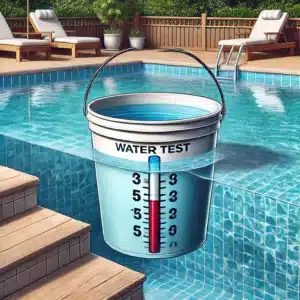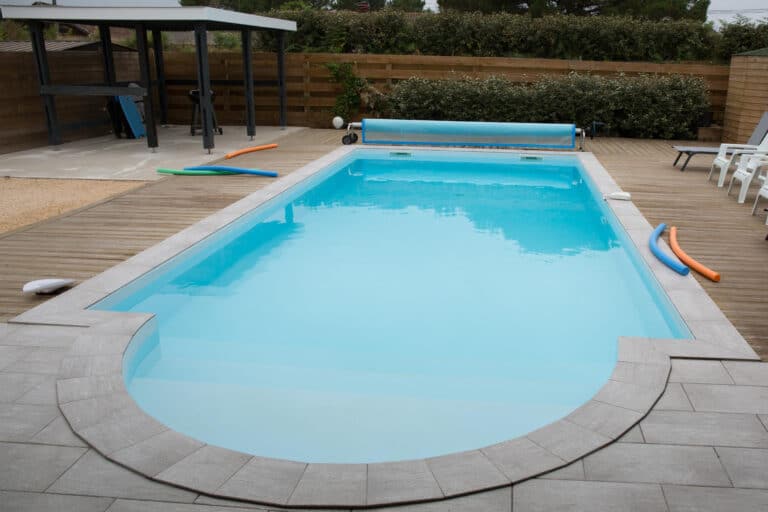Many New Jersey homeowners notice their pool water dropping and wonder if it’s normal evaporation or a sign of trouble. The truth is, a typical inground pool loses far less water to evaporation than most people think. If your water line drops more than about a quarter inch per day, chances are you’re dealing with an actual leak. This guide from Pool Patcher® explains the difference between ordinary evaporation and real water loss that requires professional pool leak repair.

Understanding Normal Pool Evaporation
All pools evaporate naturally. Warm water meeting dry air releases moisture, and wind accelerates the process. But even under hot Ocean County summer conditions, most residential pools lose **only ⅛ to ¼ inch per day**—the equivalent of roughly one to two inches per week. Anything greater usually points to a leak somewhere in the system.
Evaporation increases when:
- The pool is uncovered during sunny, breezy days
- Water temperature is much warmer than the surrounding air
- Low humidity allows faster vapor escape
- There is constant wind movement across the surface
If your water loss fits these conditions and stays under ¼ inch per day, it’s likely normal. Once the rate exceeds that threshold, further testing is recommended.
How to Tell If It’s a Leak or Evaporation
The easiest way to find out is the bucket test—a quick, reliable comparison used by professionals and homeowners alike:
- Fill a bucket with pool water and set it on the top step so the water inside and outside are level.
- Mark both levels with tape or a pencil.
- Turn off your pump and leave the pool undisturbed for 24 hours.
- Compare the levels. If the pool’s water drops noticeably more than the bucket’s, you have a leak.
Even small differences are meaningful. A loss of more than ¼ inch daily indicates something more serious than evaporation.
What a Leak Can Cost You
A minor leak can waste thousands of gallons of water in a single month. For example, losing just **½ inch per day** in a standard 16 × 32 pool equals more than 350 gallons daily—over **10,000 gallons per month**. That’s not just wasted water; it’s wasted chemicals, extra heating cost, and potential damage to the structure and surrounding soil.
Leaks left unaddressed can also cause:
- Soil erosion beneath decks and patios
- Liner stretching and wrinkles from loss of back pressure
- Broken pool pipes due to shifting ground
- Premature pump and heater failure
Common Sources of Hidden Pool Leaks
Water can escape from several less-obvious locations:
- Skimmer gaskets that dry out or separate from the wall
- Return fittings with loose threads or deteriorated seals
- Main drain connections that crack from freeze-thaw cycles
- Liner punctures caused by debris, pets, or toys
- Underground plumbing shifts creating hairline cracks in PVC
Because these issues often develop gradually, many homeowners mistake them for evaporation until water bills spike or equipment starts to draw in air.
Why Evaporation Alone Rarely Reaches an Inch per Day
Evaporation rates depend on surface area, temperature, humidity, and wind speed. In New Jersey’s coastal climate, the maximum realistic daily evaporation is around **¼ inch**. Anything approaching one inch per day would require desert-level conditions—far hotter and drier than what Ocean County experiences. If you’re losing that much water, it’s almost certainly a leak rather than natural loss.
How Professionals Confirm the Cause
Pool Patcher® uses two complementary diagnostic techniques to identify and confirm leaks:
- Pressure testing – Verifies whether each plumbing line can hold pressure without dropping. This detects cracks, loose fittings, or underground breaks.
- Electronic leak detection – Sends a harmless signal through pool water to locate the exact leak point in the structure or plumbing, accurate within inches.
Each test is billed separately unless part of a full inspection package. This ensures customers pay only for what’s needed while still receiving guaranteed, accurate results. Once the problem is verified, we perform precise pool leak repair services to restore full watertight integrity.
Preventing Future Water Loss
Even a repaired pool needs preventive care to minimize both leaks and evaporation. Simple steps include:
- Using a pool cover whenever the pool isn’t in use
- Maintaining balanced chemistry to protect gaskets and liner seams
- Inspecting skimmers, returns, and drains each spring
- Ensuring proper winterization to prevent freeze damage
- Checking for damp soil or air bubbles regularly during operation
These habits help detect small issues before they become major water-loss events.
When to Call a Professional
If you’re topping off your pool more than once a week, or notice uneven deck settling, wet spots, or visible liner wrinkles, schedule a professional inspection right away. Pool Patcher® leak detection services combine advanced diagnostics with guaranteed results for homeowners across Ocean County and surrounding regions. We locate leaks accurately without unnecessary digging or draining.
Schedule Service with Pool Patcher®
Visit our contact page to schedule your appointment or learn more about our certified pool leak repair solutions. A small leak today can become a major repair tomorrow—don’t let it drain your time, money, or peace of mind.


